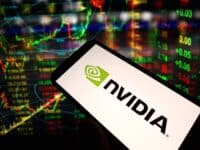

Many consider semiconductors to be a leading indicator of the markets. As some of the major names in this industry are starting to recover to their February highs, Nvidia Corp. (NASDAQ: NVDA) stands out as one of the brightest stars.
Despite Friday’s sell-off, it looks like the S&P 500, Dow Jones industrial average and the stock market in general are in recovery. As semiconductor stocks push higher, it gives more credence to the idea that the markets should follow.
After posting an all-time high of $316.13 in the middle of February, Nvidia shares followed the market down as the coronavirus epidemic spread around the world. The stock sank by about 38% in a month, before recovering to trade about 27% above where it started the year. Comparatively, Intel Corp. (NASDAQ: INTC) stock is down 4% year to date, and Advanced Micro Devices Inc. (NASDAQ: AMD) stock is up more than 8%.
Advancing Acquisitions
Last week, Nvidia Corp. announced that it had completed its long-awaited acquisition of Mellanox Technologies. The acquisition originally was announced in March of last year. The price tag on this deal came to $7 billion, while Nvidia’s market cap is roughly $183 billion.
Many are saying that this deal unites two of the world’s leading companies in high performance and data center computing. This acquisition combines Nvidia’s computing expertise with Mellanox’s high-performance networking technology.
The acquisition is expected to be immediately accretive to Nvidia’s non-GAAP gross margin. The same is true of non-GAAP EPS and free cash flow, including incremental interest expense related to Nvidia’s recent issuance of $5 billion of notes.
Jensen Huang, founder and CEO of Nvidia, commented on the completed acquisition:
The expanding use of AI and data science is reshaping computing and data center architectures. With Mellanox, the new Nvidia has end-to-end technologies from AI computing to networking, full-stack offerings from processors to software, and significant scale to advance next-generation data centers. Our combined expertise, supported by a rich ecosystem of partners, will meet the challenge of surging global demand for consumer internet services, and the application of AI and accelerated data science from cloud to edge to robotics.
The good news for investors is that Nvidia has the cash in hand to pay for Mellanox. At the end of January, the company reported cash and equivalents of $10.9 billion. The company made no share buybacks last year and paid out a relatively paltry $390 million in dividends.
Yet, over the past five years, shares have posted a gain of more than 1,200%. That includes a stock price drop of nearly a third in the final three months of 2018.
Earnings Uncertainty
Nvidia issued guidance for its fiscal first quarter back in February, before the coronavirus pandemic really took shape. At that time, the company said that it expected to post revenue of $3 billion (plus or minus 2%). Adjusted gross margins were forecast at 64.5% to 65.9%, and adjusted operating expenses are expected to ring in at $835 million.
The company offered no earnings forecast, and the first-quarter estimate includes a $100 million downward adjustment to account for potential effects of the coronavirus outbreak.
Analysts on average anticipate $1.68 in earnings per share and $2.98 billion in revenue, which compares to last year’s $0.88 per share and $2.22 billion.
Note that the earnings report is expected on May 21. This is well after competitors Intel and AMD. If anything, investors may gain some insight from these reports about what Nvidia may have in store. This ultimately could shine a light on where the broad markets may go from here.
Take This Retirement Quiz To Get Matched With A Financial Advisor (Sponsored)
Take the quiz below to get matched with a financial advisor today.
Each advisor has been vetted by SmartAsset and is held to a fiduciary standard to act in your best interests.
Here’s how it works:
1. Answer SmartAsset advisor match quiz
2. Review your pre-screened matches at your leisure. Check out the
advisors’ profiles.
3. Speak with advisors at no cost to you. Have an introductory call on the phone or introduction in person and choose whom to work with in the future
Take the retirement quiz right here.
Thank you for reading! Have some feedback for us?
Contact the 24/7 Wall St. editorial team.
 24/7 Wall St.
24/7 Wall St.


